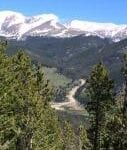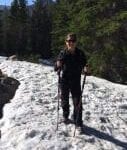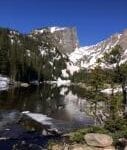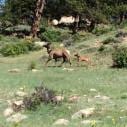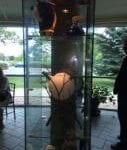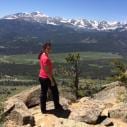Written by Marsha Seidelman, M.D.
June 8, 2014
Fortunately for me, my daughter opted to go to Colorado to celebrate her college graduation, giving me the opportunity to visit there for the first time, as well. In Rocky Mountain National Park, ‘America’s Switzerland’, the natural beauty is breathtaking and the physical abilities of the residents is so impressive. Maybe it has to do with the scenery, the health food mindset, the high level of education, peer pressure, or perhaps, people moving there purposely for the outdoor opportunities. Probably for all of these reasons, Colorado always makes it to the top of the list of states with the fittest population. There are bicyclists EVERYWHERE! I was driving on a 60 mph hilly highway, and passing dozens of them; driving on frightening hills in the mountains on hairpin turns and passing them – I was in awe! We were told that in one downhill area, cyclists had to be held to a 30 mph speed limit!
I was appreciative of the strength and commitment it took to create all the park roads, some literally between walls of rock, meandering and narrow, with sharp turns often bordering a steep incline. Carefully following the 15 mph speed limit at these points helped calm my nerves. The most frightening moment was on a very windy day, having the sensation that the huge mountains on both sides of the road were moving. I managed to keep my eyes on the road and ignore the optical illusion that could have made me lose control.
The creation of the trails also was a great feat. They often lead to bridges that allow you to walk across huge waterfalls or flowing rivers, putting you right in the path of the rushing water. This time of year, water levels are high from melted snow, making the water crashing on the rocks seem even more powerful. Some of the trails still have snow, so we used cleats and poles one day for a new experience – they were easy to use and helped us to navigate the snow and ice and mildly flooded trails.
The most interesting day was the one day we had a guide. We traveled less intent on getting to our destination, and, instead, more aware of our natural surroundings. I loved learning about how the huge boulders we saw were brought down from the highest mountains by glaciers. When the bottom level of the glacier starts to melt, it causes it to crash down the hill, dragging the attached rocks with it, creating lakes and moraines with the ‘debris’. The ‘mold’ that we saw on rocks, I learned, is what is used to determine how long they’ve been there. We saw some elkhorn sheep, many bull elk, and because it was calving season, a female with a 3-5 day old baby. It was steady on its feet, so we knew it wasn’t a fresh newborn. We were warned NEVER to get between a mom and its baby. Flowers were just starting to bloom, as around Memorial Day is when the snow melts significantly. There were poisonous yellow peas, that the animals are wise enough to avoid until fall, when the pea toxins dissipate. We saw the burnt areas from a fire in the ’70s and new young growth. There were remarkably twisted old trunks, showing the amazing strength of the wind.
One of the daily hazards this time of year is the daily afternoon electrical storms, related to the temperature and moisture activity. The rule of thumb is ‘summit by noon’ so you can be below the treeline when lightning strikes. The storms evidently travel extraordinarily quickly. We were told that if caught in one of these, we should climb down, stay away from the tallest trees, kneel on our toes and knees, but don’t lean back on your heels so you avoid having your body create a complete circuit, and crouch down as low as possible. Large rocks are good conductors of electricity, so don’t get close to those either. We were lucky to be caught in a storm only one day. We were almost at our destination when we heard thunder. We asked a family how much further to Cub Lake, our destination. The first to answer was a 3 year-old: “You’ll know you’re there when you see the lily pads!” An older native Coloradan then told us we should continue on. She said, “I climb all the time and I’m still here, ” followed by, “You just have to be comfortable with your Maker.” At that point, we decided to descend, only 1/4 mile from a beautiful lake (with lily pads, evidently). We had a few more false starts that day, limited by repeated thunder. Finally, toward evening, we made it to ‘The Pool’, on the Thomson River.
One day, we drove to one of the highest points in the park to the Continental Divide, “the backbone of America”, where waters that flow west to the Pacific abut those that flow east to the Atlantic. I mistakenly thought we could actually visualize this phenomenon, but from where we stood, it was just a concept. The drive, however, was spectacular, with many pulloffs on the road to marvel at the view.
One of the remarkable things about our adventure was noting the extremes of age of the hikers. There were families with 3 year olds as well as many people who were likely in their 70s an 80s – walking with poles, and enjoying the great outdoors. It helped me re-affirm my commitment to exercise – I want to be them! The reason they can climb at 80 is that they’ve been active for years. If you want to be active in 10 or 20 years or more, ‘train for it’ now. It’ll help you de-stress, sleep better, decrease risk for certain cancers and cardiac issues, and hopefully avoid burnout and play in the great outdoors for many years to come. It doesn’t have to be in beautiful Colorado – taking advantage of local parks, large fields, and/or blue skies wherever you are works. I for one just need to slow down enough to enjoy the outdoor beauty while I exercise. One of the great benefits about our group’s bootcamp is looking at the morning sky while on the ground to do crunches or stretches, and being far enough from my cell phone so I can’t hear it ring (except when I’m on call, of course).
Coming soon: Altitude Sickness – what it is and how to try to avoid it.



